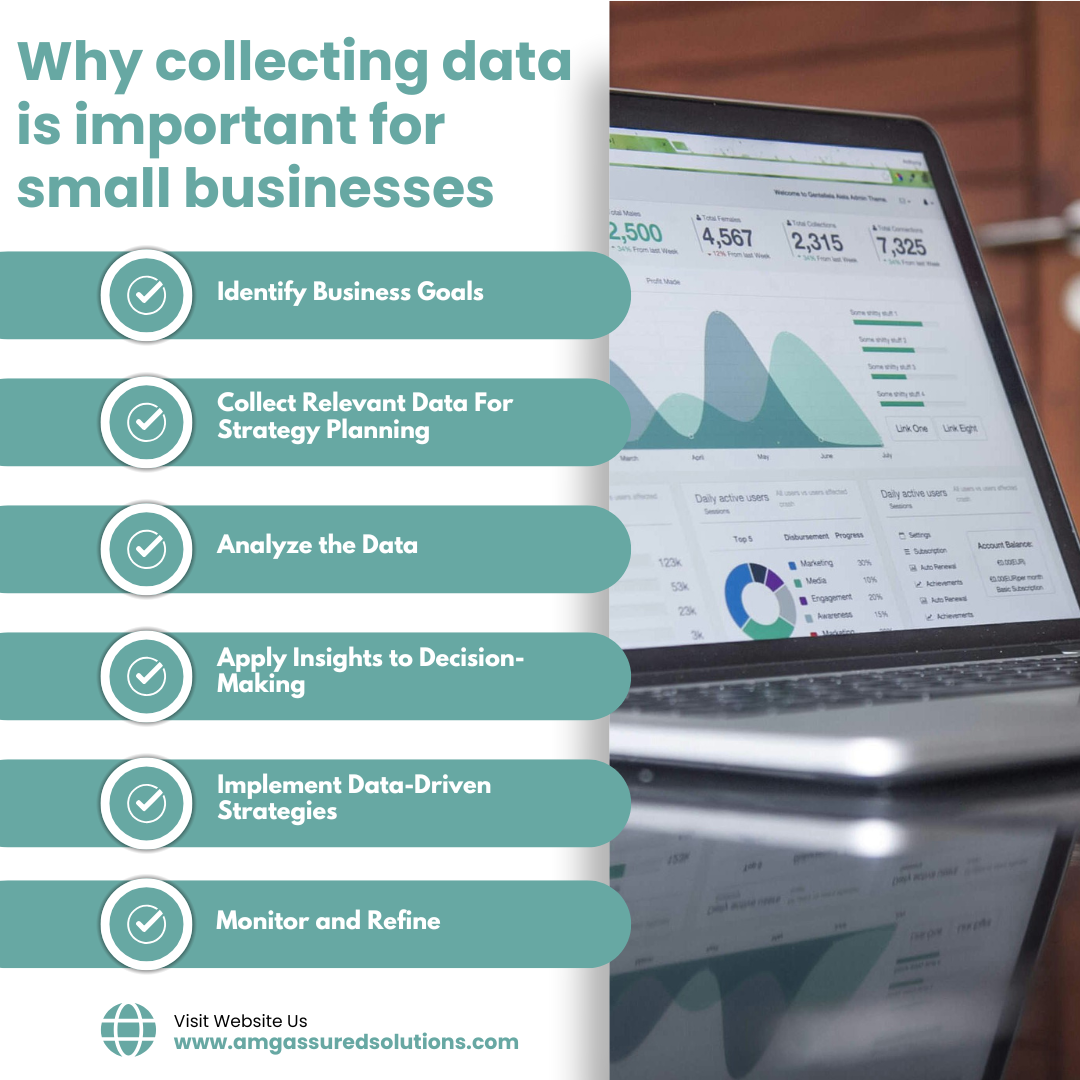Why Collecting Data Is Important For Small Businesses
January 20, 2025
By: AMG Assured Solutions
Collecting data is essential for businesses and provides a foundation to optimize efficiency and make informed business decisions. This information lets you leverage insights to make informed decisions, optimize operations, identify strengths and weaknesses, align business goals, predict trends and outcomes, enhance efficiency, and enhance customer experiences.
Here's a step-by-step guide on ways data collection can benefit businesses no matter how big or small:
1. Identify Business Goals
Examples: Increase sales, reduce costs, improve customer retention, and streamline operations.
Align data collection and analysis with these objectives.
2. Collect Relevant Data
Customer Data:
Demographics, preferences, purchase history.
Operational Data:
Inventory levels, supply chain metrics, and staff performance.
Marketing Data:
Website traffic, social media metrics, and email campaign performance.
Financial Data:
Revenue, expenses, profit margins.
3. Analyze the Data
Key Metrics to Monitor:
· Sales trends.
· Customer acquisition costs (CAC). - The cost associated with acquiring a new customer, including marketing and sales expenses.
· Lifetime value of a customer (LTV) - The total revenue a business can expect from a single customer over the entire duration of their relationship.
· Inventory turnover rates - A measure of how many times a business sells and replaces its inventory over a specific period.
· Profit margins - Profit margin is the percentage of revenue that remains as profit after expenses are deducted.
o Why It’s Important:
· CAC helps assess how efficiently you’re acquiring customers and optimizing marketing/sales budgets.
· LTV indicates the long-term profitability of customers and helps set marketing spending limits.
· Inventory Turnover: Shows how effectively inventory is managed, balancing stock levels and demand.
Profit margins indicate how efficiently a company turns revenue into profit and help compare profitability across periods or competitors.
4. Apply Insights to Decision-Making
· Optimize Inventory:
o Use sales trends to stock popular items and reduce overstock.
· Enhance Marketing:
o Target campaigns based on customer behavior and preferences.
· Improve Customer Experience:
o Personalize recommendations and communication.
· Streamline Operations:
o Identify bottlenecks and inefficiencies in workflows.
5. Implement Data-Driven Strategies
· Use A/B Testing to determine the effectiveness of marketing campaigns or operational changes by comparing two versions of a variable (such as a webpage, email, or product feature) to determine which option performs better. It’s commonly used to improve marketing, user experience, and product decisions based on data rather than intuition.
· Adopt predictive analytics to forecast demand and plan resources.
· Introduce loyalty programs based on customer data to increase retention.
6. Monitor and Refine
· Regularly review data and KPIs to measure the success of implemented strategies.
KPIs (Key Performance Indicators) are measurable values that illustrate how effectively a person, team, or business achieves specific objectives. KPIs track progress and guide decision-making by focusing on the most critical aspects of performance.
Types of KPIs
1. Financial KPIs: Monitor the financial health of a business.
o Example: Profit margin, revenue growth, cost per acquisition.
2. Operational KPIs: Track efficiency and performance of operations.
o Example: Inventory turnover, order fulfillment time.
3. Customer KPIs: Focus on customer satisfaction and engagement.
o Example: Net Promoter Score (NPS), customer retention rate.
4. Marketing KPIs: Measure the effectiveness of marketing efforts.
o Example: Conversion rate, cost per lead, social media engagement.
5. Employee KPIs: Evaluate workforce performance and productivity.
o Example: Employee satisfaction, absenteeism rate.
Data collection and tracking KPIs are fundamental for driving growth, making informed decisions, identifying strengths and weaknesses, aligning business goals, predicting trends and outcomes, enhancing efficiency, improving customer experience, facilitating benchmarking (how your business compares to competitors), supporting financial stability and creating a culture of continuous improvement. Identify what you should focus on and allow for objective measurement of success.
Want to learn more about how you can leverage your small business further? I customize revenue and goal-tracking systems tailored to your business. This resource allows you to track your business’s financial health and improves your understanding of your business’s cash flow patterns. It also helps identify growth opportunities and inefficiencies while also tracking financial goals. I will provide you with actionable strategies, tools, data, and support to achieve your business objectives and drive measurable results. If you want to learn more, please visit my website at www.amgassuredsolutions.com.
You can schedule a free informational call to learn more about how I can help you and your business.


